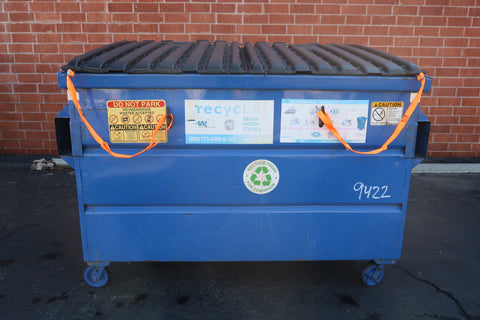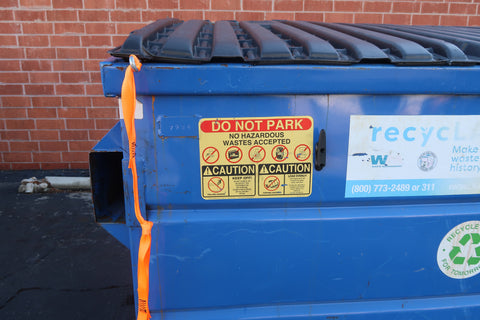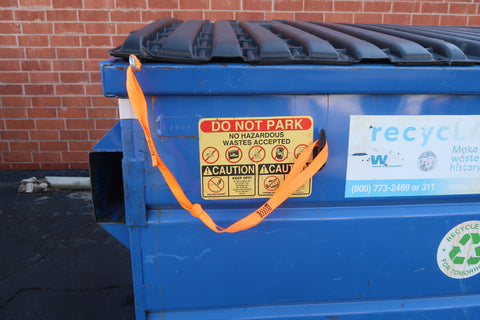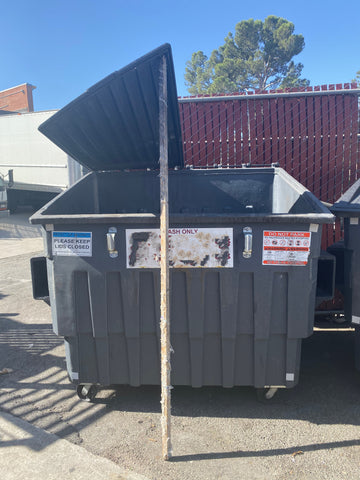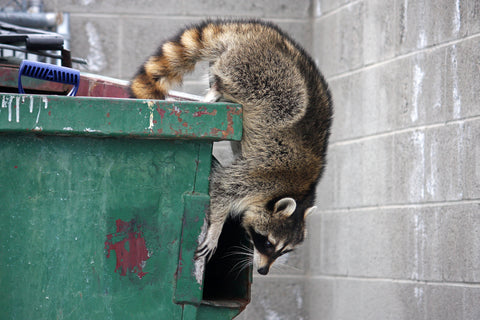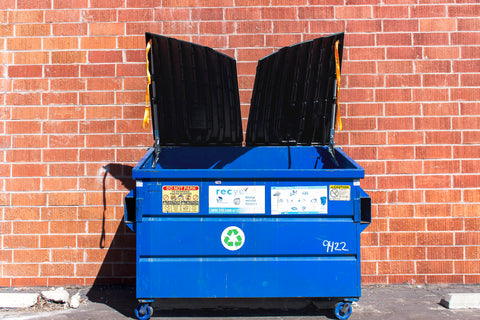Dumpsters may seem inconsequential, a trivial and unglamorous part of life, but they do pose a safety risk to those who use them. Whether you are a business or property owner, an employee, or a resident there are some things you need to know about dumpster safety.
It is just a fact of life that people and businesses create waste, so you need a way to properly dispose of it. Your property probably already has a couple of roll off bins or dumpsters where recycling and garbage are removed by waste haulers. These often big and bulky containers are super helpful for keeping trash out of your building but off your street.
There are 3 main things you need to know about dumpster safety: where to store a dumpster, how to operate a dumpster, and how to keep a dumpster clean.
1. Where to Store a Dumpster
Dumpsters, although varying in size, are big and bulky containers to have on your property. You may have asked yourself, where should I store a dumpster? Well, the simple answer is, where it functionally makes the most sense. And in order to figure that out there are some things to consider.
Who is throwing out the trash?
Dumpsters collect garbage and recycling, but they do not do it themselves…at least not in 2019. PEOPLE bring trash to a dumpster. Therefore, it is critical that your dumpster is accessible by the people who need to put trash into it.
For businesses and restaurants this could look like having your bins located within a reasonable walking distance from a back door. For a residential property or school campus you should make sure that you have enough dumpster locations to serve your entire community and that those locations are known to all.
If your dumpster location is not easily accessible by those who need to use it then you could end up with a buildup of garbage and recycling on the street, in smaller receptacles, in a parking lot, or against an outer wall of your building. If you want trash to go into the dumpster then people need to be able to get to the dumpster easily. If the process is inconvenient then people will look for shortcuts, so it is critical that you prevent this from happening by having accessible, clean, and efficient dumpster locations.
Who is seeing the trash?
Garbage is not glamorous. And dumpsters are built more for functionality than they are for being pretty. It is up to your personal preference to decide who gets to see your dumpsters. But most businesses and housing structures will choose to place their dumpsters in the back. This is an area where only the people seeking access to a dumpster, like employees or residents, will see them. Far away from your shining storefront, residents, and customers.
Another way to control the look of your dumpsters is to store them in an enclosure. You may have seen these at your local restaurant or shopping center. They look like little huts in the back of a building or corner of a parking lot. Enclosures are meant to hide and contain trash from sight as they can blend into the buildings and landscaping seamlessly. You can DIY an enclosure or get a professional for bigger projects. Just make sure that you follow all local regulations regarding the placement, dimensions, and materials used for your enclosure.
Enclosures also help to keep rodents, birds, and other pests out of your trash. A properly used enclosure also deters passersby from using your dumpsters as their personal dumping ground.
Who is picking up the trash?
A key factor of where to store your dumpster has to do with those who are picking it up. Correct dumpster placement is essential for your waste hauler. You will need to consult with your local waste hauler to make sure your dumpster is accessible by their specifications. They will be able to provide you with the requirements for how much space and clearance they need in order to properly reach your dumpster. Although there are general guidelines for this you will need to speak with your waste hauler for a definitive answer.
2. How to Operate a Dumpster
Have you ever found yourself having to juggle balancing the big lids open while hoisting your heavy bags up and into the bin? One of the most underestimated things about your dumpster is the safety risks and potential injury involved in its operation. The mixture of big bulky lids and heavy trash bags creates a concoction of chaos.
But fear not, we have some tips for you so that can minimize those risks and safely dispose of your trash and recycling.
Opening and Closing Dumpster Lids
One of the greatest challenges lies in the lids. Dumpster lids are big and heavy. And for shorter folks they can also be out of reach. Here are the best tips for opening and closing your dumpster lids safely and with ease:
- Get a professional step stool to store next to your dumpster. The added height will allow you to reach the lids easier.
- Make sure to not touch dumpster lids that have been in direct sunlight for a while. Most dumpster lids are black and can get very hot. So be cautious of lid temperature before direct contact with your skin.
- Use both hands to open and close dumpster lids. Make sure you have full control of the lid. The lids are heavy and could lead to injury when dropped.
- Be aware of pinch points and keep careful watch of your hand placement. These big lids are heavy and can pinch and smash your hands and fingers if you are not careful. Common pinch points are anywhere where the lid meets the frame of the dumpster and the hinges that secure the lid to the back of the dumpster.
- Make sure the lid is opened all the way. If you cannot open the lid all the way due to dumpster placement then make sure that it opened to where it can stay open without being held. This may mean steadily leaning the lid against a wall or enclosure.
- DO NOT prop open dumpster lid with poles, planks, boxes, etc. Lid propping is not only a code violation for most buildings, but it increases safety risks as the prop could come loose and cause the lid to fall. Open dumpster lids also expose your dumpster to pest infestations and spreading of odors.
- You can purchase a dumpster lid opener that will do the opening and closing for you.
Properly Lifting Trash into Dumpster
Dumping heavy trash bags requires a lot of force and awkward postures/positions. There is a high risk of pulling muscles and hurting your back if you do not lift properly. Follow these steps to lift trash bags properly and reduce risk:
- Face the front of the dumpster, toss bag forward into the dumpster.
- Use a step stool to reduce lifting above shoulder height
- NEVER try to hoist bags into your dumpster while holding the lid open. Always place the bag on the ground first, open lid (see tips above), then pick up bag with both hands
- Do not twist your body – avoid tossing trash in while standing sideways
- Always lift with your legs instead of bending over. This puts more strain on your back.
- Get help if the load is too heavy or awkward
You can also reduce the amount of lifting necessary when taking out the trash by:
- Using smaller garbage cans and bags
- Position trash bags as close to dumpsters as possible
- Have trash cans that can be rolled to the dumpster
- Get a pushcart or tilt truck that can bring multiple bags of trash to the dumpster
- Invest in a manual or electric trash can dumper or cart lifter
Never Enter a Dumpster
Dumpsters are full of waste that can be sharp, heavy, and full of germs. If you enter a dumpster you are putting yourself at risk of cuts and contamination. In fact, you should never extend your body over a dumpster. And do not compress or move items in a dumpster with any part of your body.
Do Not Dispose of Hazardous Waste
Your average solid waste dumpster is not meant for hazardous materials . All hazardous materials must be disposed of properly . Check your state and local regulations to determine the proper way to dispose of these hazardous materials.
3. How to Keep Dumpster Area Clean
Dumpsters have a reputation of being unglamorous and dirty. And to be fair, it is because often they are unglamorous and dirty. An important part of dumpster safety is making sure that you keep the area surrounding a dumpster clean.
Clean Surrounding
For the safety of those taking out the trash, it is important to have unobstructed access to the dumpsters. This also means to avoid any tripping hazards surrounding your bins. Make sure the area around your dumpster is flat, clear, and free from tripping hazards.
It is also critical to make sure that rodents, birds, animals, and other pests are not getting into or residing in your dumpsters or the area surrounding. Make sure to notify management if there is a pest infestation. Keeping the area around your dumpster clean and clear will minimize pests from entering the area.
No Overfill or Overflow
Do not overfill your dumpsters. It is important not to let trash pile up in your dumpsters because this can lead to debris spreading across your property and into our environment. Overfill can lead to overflow – and you do not want trash outside your dumpster. Overflow is unsightly, spreads odors and germs, and attracts animals and pests. Your dumpster lids should always be able to close firmly. This allows you to stay compliant with your local codes and allows your waste haulers to properly pick up your trash.
If overfill is a common occurrence, then that may be a sign that your building needs more dumpsters to manage the amount of trash. You can check in with your local waste hauler to see what options are available to you for getting an additional dumpster. But also check to make sure that all your dumpsters are accessible and being used. Sometimes dumpster lids are left open to make the process more convenient for the next time, so trash will pile into those dumpsters. The dumpsters with properly closed lids are then not utilized because it is inconvenient to have to lift the lid. Therefore, it is important to encourage those who are taking out the trash to utilize the bins properly by always opening and closing the dumpster lids safely.
Cleaning A Dumpster
If the odor, grease, and grime is just unbearable then you can clean your dumpster. Cleaning your dumpster is a great way to kill germs and bacteria that builds up and to reduce emanating odors. How often you should clean your dumpster will vary, but typically you would not need to clean it more than once a month.
One option would be to hire a professional cleaning company that specializes in dumpster cleaning to do the work for you. This is the safest way as cleaning your dumpster poses safety and environmental risks.
If you decide to try cleaning your dumpster yourself then makes sure to use eco-friendly and biodegradable cleaning agents. Runoff from the dumpster cleaning impacts the environment so it is critical that you are using natural products. You will want to clean your dumpster in a space where the water can flow away into the gutters. If the water is not able to runoff then the bacteria and smell will stay in the area.
Make sure that your dumpster is completely dry before putting trash into it. If you start putting garbage in the dumpster before it is completely dry, bacteria will spread and the odor will linger.
Congratulations! You have successfully made it through Dumpster Safety 101. You now have the knowledge, tips, and tricks to properly store a dumpster, safely operate a dumpster, and keep the dumpster area clean.
Feel free to reach out if you have any additional dumpster safety questions or tips not mentioned in this post.




